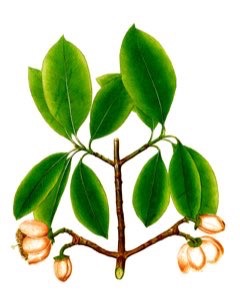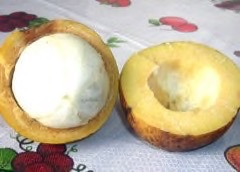 |
|
http://www.edibleplants.org |
 |
| Hellen Perrone wikimedia.org |
Translate this page:
Summary
Commonly known as Bakuri, Platonia insignis, is tropical large tree growing about 25-40 m in height and 1.5 m across. It has a straight trunk, opposite branches, shiny leaves, and large pink flowers. The fruit of Bakuri is yellow when ripe, round, and comprised of thick rind and white flesh. The fruit can either be consumed raw or made into desserts. Bark decoction is used against diarrhea. Seed oil, when combined with sweet almond oil, is used in the treatment of eczema and herpes. It is also utilized in the soap and candles production. The bark yields fiber and black resin - the fiber is made into ropes while the resin is used as sealant in boats. Bakuri wood is heavy, elastic, moderately hard to hard, moderately strong, and resistant to attacks of dry-wood borers and termites.
Physical Characteristics

 Platonia insignis is an evergreen Tree growing to 25 m (82ft) by 20 m (65ft) at a fast rate.
Platonia insignis is an evergreen Tree growing to 25 m (82ft) by 20 m (65ft) at a fast rate.
See above for USDA hardiness. It is hardy to UK zone 10.
Suitable for: light (sandy), medium (loamy) and heavy (clay) soils. Suitable pH: mildly acid, neutral and basic (mildly alkaline) soils. It cannot grow in the shade. It prefers moist or wet soil.
UK Hardiness Map
US Hardiness Map
Synonyms
Aristoclesia esculenta (Arruda) Stuntz Moronobea esculenta Arruda Platonia esculenta (Arruda) Oken
Plant Habitats
Edible Uses
Edible Parts: Fruit Oil
Edible Uses: Oil
Fruit - raw or cooked to make sherbet, ice cream, marmalade or jelly[336 ]. The white, pithy pulp has a pleasant odour and an agreeable, subacid flavour[336 ]. The fruit is yellow when ripe, nearly round or ovoid, 75 - 125mm wide, weighing up to 900 g[336 ]. The rind is yellow, hard, fleshy on the inside, 1 - 2 cm thick, and contains gummy, yellow, resinous latex[336 ]. The infertile seed compartments are filled with pulp called 'filho 'which is the part preferred[336 ]. The oil is unlikely to be edible.
References More on Edible Uses
Medicinal Uses
Plants For A Future can not take any responsibility for any adverse effects from the use of plants. Always seek advice from a professional before using a plant medicinally.
Antidermatosic Antidiarrhoeal Astringent Eczema
The seeds contain 6 to 11% of an oil that is mixed with sweet almond oil and used to treat eczema and herpes[336 ]. The bark is astringent. A decoction is used to treat diarrhoea[348 ].
References More on Medicinal Uses
The Bookshop: Edible Plant Books
Our Latest books on Perennial Plants For Food Forests and Permaculture Gardens in paperback or digital formats.

Edible Tropical Plants
Food Forest Plants for Hotter Conditions: 250+ Plants For Tropical Food Forests & Permaculture Gardens.
More

Edible Temperate Plants
Plants for Your Food Forest: 500 Plants for Temperate Food Forests & Permaculture Gardens.
More

More Books
PFAF have eight books available in paperback and digital formats. Browse the shop for more information.
Shop Now
Other Uses
Fibre Furniture Lighting Oil Resin Soap making String Waterproofing Wood
Other Uses: A non-drying oil, known as 'bakuri oil', is obtained from the seed[46 ]. It is used for the manufacture of candles and soap[46 ]. A fibre obtained from the bark is used for cordage[378 ]. A black, viscous resin obtained from the bark is used for caulking boats[378 ]. The heartwood is dull-yellow to orange-brown with many fine, dark, often black streaks; it is clearly demarcated from the 3 - 9cm wide band of yellowish-white sapwood. The texture is coarse to medium; the grain generally straight but at times irregular; the lustre is low. The wood is heavy; moderately hard to hard; moderately strong; elastic; durable in the soil and resistant to dry-wood borers and termites. It seasons somewhat slowly, with a high risk of checking and distortion; once dry it is poorly stable in service. It has a fairly high blunting effect, stellite-tipped and tungsten carbide tools are recommended; although hard, it is easy to work with both hand and power tools; nailing and screwing are good, but require pre-boring; gluing is correct for interior purposes only; it polishes well. It is valued for construction, high class furniture, flooring, ship-building and general carpentry[46 , 336 , 378 , 848 ].
Special Uses
Food Forest
References More on Other Uses
Cultivation details
A plant of the moist, lowland tropics[336 ]. Succeeds in a sunny position[419 ]. Plants are tolerant of various soil conditions, including poor drainage, but dislike dry soils[335 , 419 ]. In some areas within its native range this tree is viewed as a weed because it proliferates from fallen seeds and, if felled, produces abundant suckers from the roots[336 ]. A rather fast-growing tree[419 ]. Bloom Color: Pink.
References Carbon Farming Information and Carbon Sequestration Information
Temperature Converter
Type a value in the Celsius field to convert the value to Fahrenheit:
Fahrenheit:
The PFAF Bookshop
Plants For A Future have a number of books available in paperback and digital form. Book titles include Edible Plants, Edible Perennials, Edible Trees,Edible Shrubs, Woodland Gardening, and Temperate Food Forest Plants. Our new book is Food Forest Plants For Hotter Conditions (Tropical and Sub-Tropical).
Shop Now
Plant Propagation
Seed - best sown as soon as it is ripe in a partially shaded position in individual containers. A high germination rate can usually be expected, with the seed sprouting within 20 - 40 days[419 ]. The seed has a very short viability of less than 30 days in the wild[419 ].
Other Names
If available other names are mentioned here
Bacupari, Bacuri, Bacuri assu, Bacuri do para, Bacury, Geelhart, Goherica, Ko, Maniballi, Packoeri, Pacuri, Pakoeri, Pakouri, Pakuri, Parcouri, Pacoury-uva, bacuripari
Native Range
SOUTHERN AMERICA: Guyana, Suriname, Venezuela, Brazil, Amazonas, Maranhão, Pará, Piauí, Amapá, Roraima, Tocantins, Colombia, Guainía, Vaupés,
Weed Potential
Right plant wrong place. We are currently updating this section.
Please note that a plant may be invasive in one area but may not in your area so it's worth checking.
In some areas within its native range this tree is viewed as a weed because it proliferates from fallen seeds and, if felled, produces abundant suckers from the roots[336 ]
Conservation Status
IUCN Red List of Threatened Plants Status : This taxon has not yet been assessed

Growth: S = slow M = medium F = fast. Soil: L = light (sandy) M = medium H = heavy (clay). pH: A = acid N = neutral B = basic (alkaline). Shade: F = full shade S = semi-shade N = no shade. Moisture: D = dry M = Moist We = wet Wa = water.
Now available:
Food Forest Plants for Mediterranean Conditions
350+ Perennial Plants For Mediterranean and Drier Food Forests and Permaculture Gardens.
[Paperback and eBook]
This is the third in Plants For A Future's series of plant guides for food forests tailored to
specific climate zones. Following volumes on temperate and tropical ecosystems, this book focuses
on species suited to Mediterranean conditions—regions with hot, dry summers and cool, wet winters,
often facing the added challenge of climate change.
Read More
Expert comment
Author
Mart.
Botanical References
Links / References
For a list of references used on this page please go here
A special thanks to Ken Fern for some of the information used on this page.
Readers comment
| Add a comment |
|
If you have important information about this plant that may help other users please add a comment or link below. Only comments or links that are felt to be directly relevant to a plant will be included. If you think a comment/link or information contained on this page is inaccurate or misleading we would welcome your feedback at [email protected]. If you have questions about a plant please use the Forum on this website as we do not have the resources to answer questions ourselves.
* Please note: the comments by website users are not necessarily those held by PFAF and may give misleading or inaccurate information.
To leave a comment please Register or login here All comments need to be approved so will not appear immediately.
|
Subject : Platonia insignis
|
|
|
|